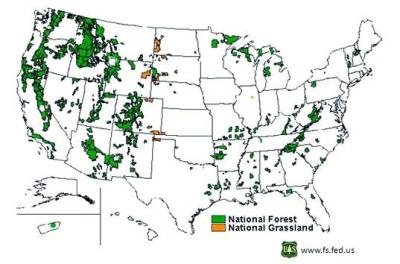Ecosystem
An ecosystem is a natural system formed by a collection of live organisms, such as plants and animals, and the physical environment in which they live (such as rocks, soil, water, etc.). The U.S. Forest Service (USFS) manages 193 million acres of National Forests and Grasslands and their diverse ecosystems.

The variety of ecosystems in the world can be generally identified by vegetation zones–in these zones, we can predict the existence of certain species of trees, plants, and animals based on the weather, the soil, the presence or absence of humidity, and other physical variables. In the United States, zones include chaparral, desert, grassland, and diverse types of forests, including mixed coniferous, deciduous forest, boreal forest, tropical rainforest, temperate rainforest, wetlands, and montane forest. Despite their vast diversity, there is one element that unites all forests; they are mostly made up of trees.
Some information about the importance of our National Forests and Grasslands:
- The USFS manages the largest single source of water in the U.S.–almost 20% of all the water in the country–providing drinking water to more than 180 million people.
- Natural areas help to alleviate climate change because they capture and store carbon dioxide; about 20% of a tree’s weight is made up of carbon.
- There is great biodiversity in our forests and grasslands, including critical habitat for the conservation of plant, animal, and insect species in danger of extinction.
- They provide wide-open and safe spaces where everybody has the chance to recreate and share with family and friends.
- There are many specialists working together to ensure that our natural public areas are sustainable and healthy today and for future generations.
